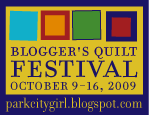Reverse engineering and how I learned to quilt
For 17 of the projects in that special issue, we rented antique quilts from an store that specialized in such things. Then we wrote instructions so that people could recreate them. Remember, this was the early '90s, when rotary cutting and quick piecing were still in their infancy. And I knew nothing about quilting. Our editor had the solution--he was friends with Liz Porter of Fons and Porter and she came to the office for a three-day seminar on all things quilting. Not only did I learn a lot about quilting, but I also learned a skill that's been invaluable--the ability to reverse-engineer a quilt. Since we were working with antique quilts, we had to chart and measure and dissect each quilt and how it was constructed (or how it would be, using modern techniques) without doing one bit of damage to them. So now, I can look at a picture of a quilt or an actual quilt, chart it out, write instructions, and figure out how much fabric is needed. It's a great skill to have for designing my own quilts, and it's come in handy at other times in my life.
For instance, a customer came into the quilt shop one day with a family heirloom quilt. She'd received it from a family member, but felt a little guilty that she got it instead of some other family members. So she wanted to create similar quilts for them. After some quick math, I drafted a pattern for her and figured yardage and together, we picked out fabrics for her to get started. I remember it having some great colors in it and a black polka-dot on a white background, but that's all I remember. I didn't ever get to see the finished quilts, but I hope her family members appreciated the work she did.
So my engineering friends from college might be able to reverse-engineer equipment, but I can reverse-engineer a quilt.
Subscribe to:
Post Comments (Atom)



3 comments:
Just found your blog. I really like the title of it. It is always so interesting to get a peek behind the scenes in the various aspects of the quilt business world. Thanks for sharing your experience. Also very enlightening as to how it helped you acquire new skills in analyzing a pattern and re-creating it's construction without de-constructing the quilt! I love studying antique quilts and quilt history. Karen
That's kind of like people who can look at a dress or other article pf clothing and create their own pattern. Definitely a useful skill!
Thanks for this such a good info I'm looking forward for your more post regarding this. Thanks!
Post a Comment
Comments are welcome but will be moderated. Thanks for commenting! I love feedback!